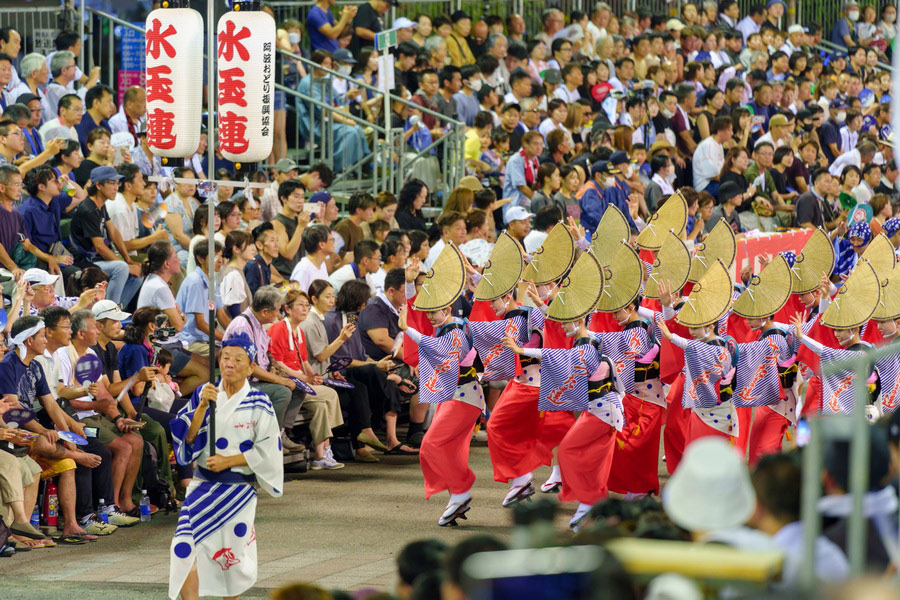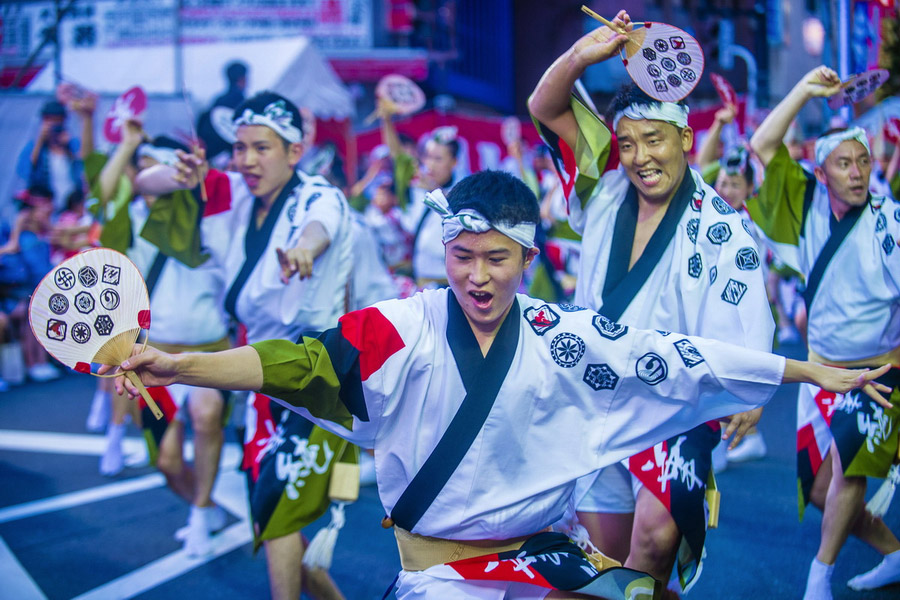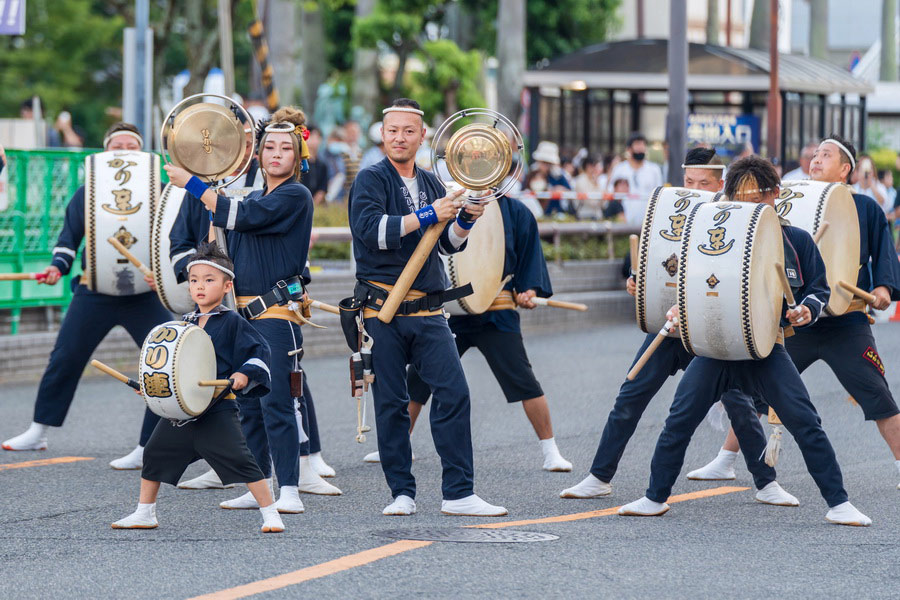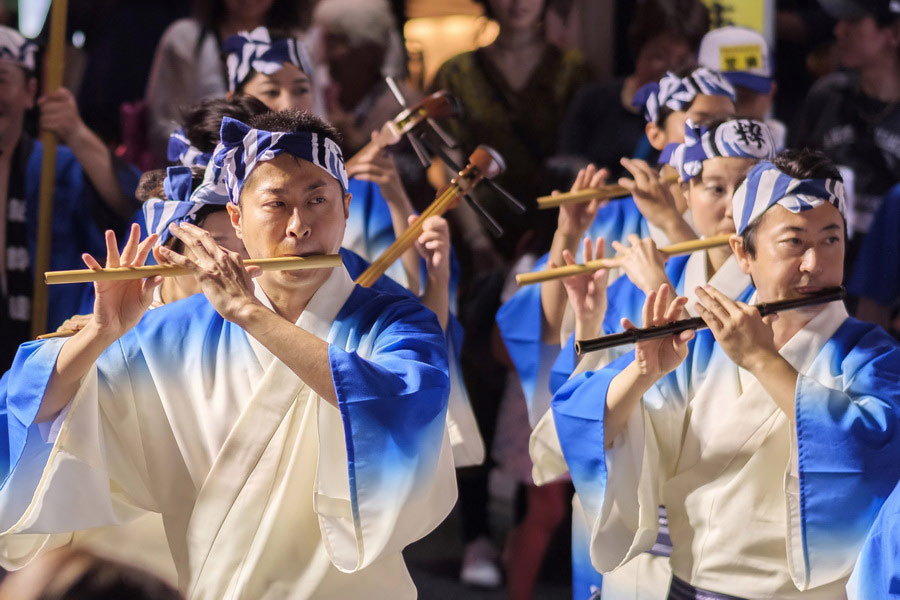
Awa Odori Matsuri (阿波踊り, the Awa Dance Festival) is one of Japan's oldest and most famous dance festivals, held annually in Tokushima Prefecture (徳島県) on the island of Shikoku (四国). Attracting hundreds of thousands of tourists and participants from all over the country, this colourful festival has a centuries-old history and deep cultural roots. Awa Odori (阿波おどり) is a symbol of Japanese national tradition, embodying the spirit of unity and respect for ancestors.
Awa Odori is celebrated during Obon Matsuri (お盆), a traditional Japanese festival to honour the memory of the ancestors, from 12 to 15 August. The main event takes place in the streets of Tokushima.
History of the Festival

The name “Awa Odori” is composed of two parts: "Awa", the old name of Tokushima Prefecture, and "Odori", which means dance. The festival's dance style has evolved over the centuries, borrowing movements from the Buddhist dances of Nembutsu Odori and Hiji Odori of the Kamakura period (鎌倉時代) (1185-1333).
Several theories explain the origin of Awa-odori:
- Celebration of the completion of Tokushima Castle (徳島城): One of the most widely accepted theories is that Awa Odori originated in 1586 when Prince Hachisuka Iemasa (蜂須賀 家政) held a grand celebration for the completion of the construction of Tokushima Castle. The locals, inebriated on sake, began dancing carelessly in the streets, leading to the development of a structured festival. This is reflected in the first lines of a song sung during the dance:
Awa-no tono-sama Hachisuka-sama-ga ima-ni nokoseishi Awa Odori
What the ruler Hachisuka has left us to this day is Awa Odori
- Bon Odori influence: Another theory links Awa Odori to Bon Odori (盆踊り), a dance performed during the Obon (お盆) festival to honour ancestral spirits. It is believed that locals in the Awa region created their own unique style of Bon Odori, which later became known as Awa Odori.
Over the centuries, Awa Odori developed and gained popularity beyond Tokushima. During the Meiji era (明治) (1868-1912), the festival was discontinued due to the bankruptcy of Tokushima's indigo producers, who had financed the event.
In the twentieth century, the festival was revived and acquired its current name and status as the most vibrant event in the prefecture. With the advent of modern media, Awa Odori began to attract an increasing number of international tourists. Today, it is an integral part of Japan's cultural life and a symbol of Tokushima Prefecture.
Performing Awa-odori

The festival has several key elements:
Ren (連) dance
Ren are groups of dancers dressed in traditional costumes who perform synchronised movements to the sounds of Japanese musical instruments such as drums (taiko, 太鼓), flutes (fue, 笛/ふえ), and bells (kane or shō, 鉦 or 鐘). Each ren has its own distinct style, costume, and music, reflecting the identity of the region—the dancers' home. This diversity makes the festival colourful, dynamic, and engaging. Although the outfits differ, there are common features: all female dancers wear the traditional straw hat amigasa (編笠) and a yukata (浴衣), a light summer kimono, which emphasise elegance and rhythmic movement, while males wear a hanten (袢纏) jacket and a happi (法被), a light festival coat). Groups can be both professional and amateur.
Male and Female Dance Styles
There are two styles of dance in Awa Odori: the dance performed by men, otoko-odori (男踊り) and the one performed by women, sonna-odori (女踊り). The men perform powerful and somewhat rough movements, crouching low with their knees outward and their arms raised above their shoulders. Women's group dances are graceful and elegant, characterised by fluid gestures and high arm movements. Children and teenagers under the age of 20 typically perform in a masculine style.
Songs and Music

Musical accompaniment plays an important role in the dances. They are performed to the traditional song "Awa-Yoshikono", with the rhythm provided by drums, flutes, and the shamisen (三味線), a stringed instrument similar to a guitar. The melody of the song originated from the Ibaraki region(茨城県), but sounds from Kumamoto Prefecture (熊本県) are also audible. This song is sung at procession breaks, usually in larger areas with special stands for paid spectators. Not all ren have a main singer, so the following lyrics of the dance of fools can often be sung by the dancers:
踊る阿呆に 見る阿呆 同じ阿呆なら 踊らな損、損
Odoru ahō ni, miru ahō, onaji ahō nara, odorana son, son
The dancers are fools, the watchers are fools; both are fools, so why not dance?
Those lyrics reflect the philosophy of Awa Odori: it doesn't matter how good you are at dancing; what matters is that you enjoy and participate in the celebration.
The song is also accompanied by calls and responses (hayashi kotoba): "Ayattosa, Ayattosa", "Hayattya yattya", "Erai yattya, erai yattya" and "Yoi, yoi, yoi, yoi, yoi". These words may have no specific meaning, but they energise the dancers and set the rhythm of the procession.
Awa Odori Matsuri attracts more than a million spectators and participants every year. The streets of Tokushima are transformed into a huge stage where Japanese tradition and modernity meet, captivating everyone with an atmosphere of fun and unity. The festival has also spread beyond Tokushima, and similar dance events are now held in other major Japanese cities, including Tokyo (東京都), Kobe (神戸市), and Osaka (大阪市), demonstrating the importance of Awa Odori in Japanese culture.


